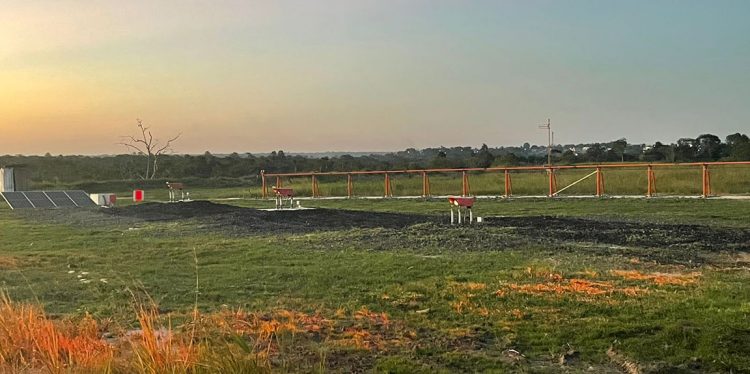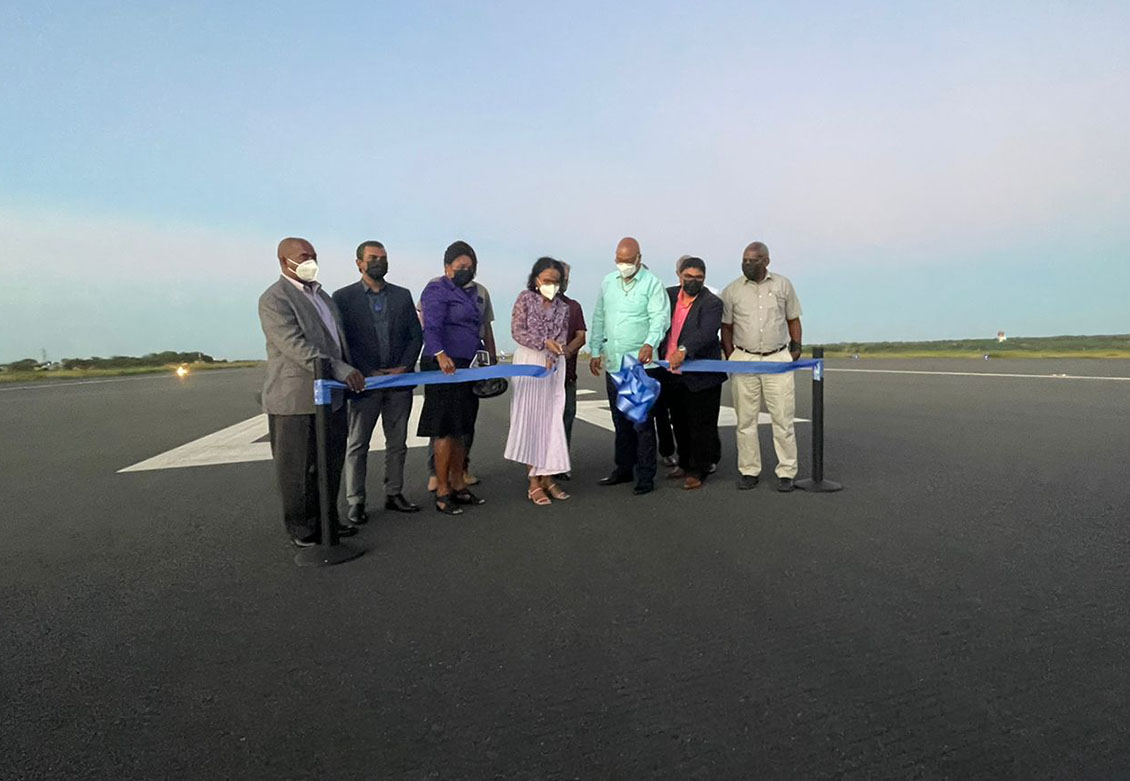The operationalisation of the newly installed Instrument Landing System (ILS) at the Cheddi Jagan International Airport (CJIA) is expected to significantly reduce flight diversions and delays by 90 per cent, Minister with responsibility for the aviation sector Juan Edghill announced yesterday.
The technology which was commissioned to the tune of $518 million with the localizer costing $200 million, the glide path $282 million, and the precision markers costing $36 million, is set to boost the airport’s efficiency and save airlines thousands of dollars.
Aircraft arriving at the CJIA will be able to land in poor visibility conditions as the technology will offer guidance to the pilots and flight crew during landing at the airport.
Speaking at the commissioning ceremony of the ILS and the expanded airport runway, which is now one of the longest in the region, Edghill said that the availability of a precision approach instrument landing system serves to enhance safety in aircraft operations during critical stages of flight.
“With fewer holds due to fog and other weather phenomenon, the efficiency and capacity of the airport operations will be enhanced with the operationalising of the ILS,” Edghill said.
Prior to the operationalisation of the equipment, during fog and low cloud coverage, pilots were forced to divert to neighbouring countries or circle the airspace hoping for a clear path to land. Just a few months ago, heavy fog in the early morning forced two American Airlines flights to be diverted to Suriname and Brazil.

Chairman of CJIA’s Board of Directors, Sanjeev Datadin in his address pointed out that the new piece of equipment will allow pilots to make a determination on landing even if the low cloud coverage, which is normally between 200 and 500 feet. “Pilots should not have difficulties with visibility anymore… the ILS will aid significantly in us not needing to divert flights if there is low cloud coverage,” Datadin said. Speaking from data collected, the board chair noted that annually, approximately 12 out of every 3,700 flights are forced to be diverted or redirected until they can land.
Director of Air Navigation Services Rickford Samaroo in his brief remarks noted that with the announcement of a modernised airport, they were forced to reexamine the design and installation of the system. He noted that after much consultation and negotiation with the company, Intel Cam Techno-System, they were able to configure the right design.
He explained that the components installed are fully calibrated and flight checked and have been under testing since July. The ILS has been in operation since September 9, and over 30 arrivals have utilised it.
Explaining the functionality of the three components, Samaroo said “… The localizer gives horizontal guidance to the airplane on the center line, while the glide slope gives vertical guidance and precise three degrees and sink into the runway and the distance measuring equipment gives the pilot an awareness to go before touch down…”
Edghill noted too that according to the International Civil Aviation Organization (ICAO) standards, the ILS must be inspected every 18 months.
Runway
Public Works Minister Edghill also commissioned the airports new runway which now measures 11,023 feet. The runaway is part of the US$150 million cost of the modern CJIA project, which has been under construction since 2012.
Edghill in his address said this facility will now serve as a marketing point to airlines since it can accommodate larger aircraft and carry their maximum weight.
“The CJIA now has increased capacity for larger and modern carriers. Previously many wide-bodied aircraft including the B747 had to operate with restrictions into CJIA…Today we can accommodate most modern passenger-carrying aircraft including the Boeing 777 and Airbus 350 and 321,” Edghill boasted as he said the project is finally being realised.
He posited that with the length of the runway, aircraft will be able to take off with their optimal weight of baggage and passengers in the same flight.
“Airline will be able to carry their outgoing passengers’ baggage and the full fuel capacity so during peak periods there should be no bags left behind,” the Minister opined.
He said too that he is optimistic that airline competiveness can become more creative and robust with the new facilities at the CJIA.
Meanwhile, Datadin explained that with an expanded runway, should an aircraft need to abort its take off, it can do so in a safe environment with the weight on board.
“This new runway will allow the large aircrafts to carry the full weight more cargo and of course commercial they can carry full passenger quotas…” he said.
Initially, the runway was to be constructed at the length of 10,800 feet but after modifications it was extended and was completed in March of this year.
Noting that the runway completion is only one part the infrastructural development, he said they will continue to invest to enhance the safety and efficiency of aircraft operations.
“We recognised that the aviation industry is capital intensive and hefty investments are required to ensure these safety critical aviation activities and infrastructure are compliant with the thousands of international civil aviation standards,” he stressed.
Additionally, Edghill stated the aviation sector is strategic to the development of Guyana and that his government has envisioned the aviation sector as one of the main arteries for sustainable national development. He stated that over the past years there has been upward trend in the aviation sector signalling positive growth.
“Our government will continue to promote the development of this sector but we must overcome the challenges that will present themselves as we strive towards building and sustaining a strong vibrant aviation sector,” he underscored.






